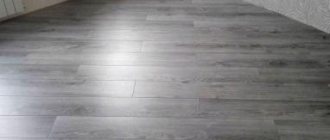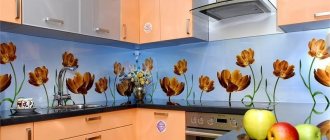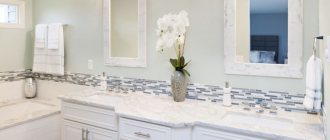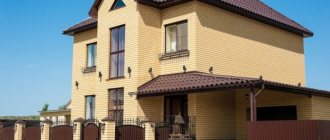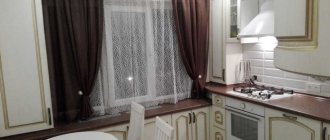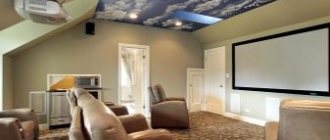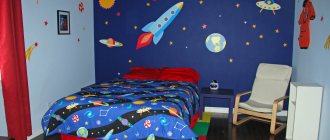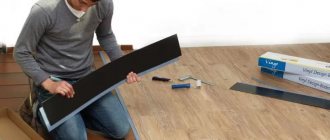What is special about laminate walls?
The use of laminate as a finishing material for walls in the kitchen is dictated by its main advantages. These include:
- ease of installation. Even novice craftsmen can perform the entire complex of work;
- availability. In terms of cost, laminated boards are significantly inferior to solid wood panels and parquet boards;
- wear resistance. A material of a suitable class resists external influences well. The formed coating retains its presentable appearance for a long time;
- soundproofing properties. Walls lined with laminate better protect the interior from external noise;
- the ability to select panels with improved characteristics that are not afraid of exposure to high temperatures, high humidity and shocks;
- a large assortment. You can choose boards of a suitable color and with the desired texture;
- possibility of zoning space. Laminated panels help place accents and attract attention;
- ease of care.
Although laminated boards have many advantages, when choosing this method of finishing walls in the kitchen, you need to remember that:
- prolonged contact with water and prolonged exposure to high humidity reduce the service life of the panels and deteriorate their appearance;
- Careful leveling of the base may be required;
- the possibility of using the material to decorate a small area of wall.
Methods for laying laminated panels on a kitchen wall
Two installation options are available:
- fastening panels with glue;
- installation using lathing.
If you are going to cover the walls in a small kitchen with laminated panels, then it is more rational to use the adhesive method. It will save the space of the room. If the kitchen is spacious, it is worth making a frame from slats and attaching slats to them. This fastening method is more reliable.
Let's consider both methods.
Gluing laminated planks to the wall surface
This method is most suitable for a small kitchen, because... it makes it possible not to reduce space. A laminate with a small thickness is quite suitable; it will stick to the wall surface with silicone.
Important: the surface of the wall must be made perfectly smooth for installation using this method. To level the walls, you can use plasterboard, plywood, or simply correct the wall surface well with plaster.
Installation sequence:
- We begin laying the lamellas from the lower left corner, from the floor.
- We attach a stop under the first row of planks on the floor; this will prevent the planks from sliding down.
- The glue is applied in a wavy line to the back of the panel and to the surface of the wall.
- The first row of lamellas is laid level, with the groove up. Each lamella must be pressed well against the wall surface.
- As you work, you need to wipe off the glue that comes out between the panels.
- The next row is laid with a shift relative to the previous row (brick laying method) so that the joints between the panels of adjacent rows do not coincide.
Before finishing the walls in the kitchen with laminate, you should remove the door frames (if the finishing reaches the doors) and install them on top of the panels.
Installation of laminated boards on lathing
This fastening method is more reliable. In this installation option, it is better to choose long and wide panels, this will reduce the working time. This fastening method does not require pre-leveling the wall surfaces.
Installing a wooden frame:
- the frame is made of wooden blocks measuring 44x74 mm or 40x40 mm;
- in the first block we make several through holes in increments of approximately 30 cm;
- Next, you need to attach this block to the surface of the wall in a vertical position, set using a level. We mark with a pencil the locations of future holes on the surface of the wall for dowels;
- We make the intended holes, insert dowels into them, and strengthen the first vertical block to the wall surface. We do the same with other bars; we place them on the wall so that the edges of the panel fall on the block.
The laminated panel should be attached to the sheathing at approximately three points. After strengthening the wooden frame, we begin to lay slats on it:
- We fasten the bottom panel to the sheathing with the groove up using self-tapping screws with a recessed head; we make this fastening lower to the floor so that in the future it will fall under the baseboard.
- We nail the edge of the upper part of the board to a wooden block with nails, recessing their heads into the board material, otherwise the connection of the lamellas will be loose, with cracks. Fastening with nails can replace a stapler.
- The second row and all subsequent ones are laid out using the bricklaying method, with an offset relative to the joints in the adjacent row.
What characteristics should you pay attention to when choosing?
When starting to choose a suitable model, you should decide on the purpose of the purchase. If you need to disguise crumbling plaster, you should choose rigid panels of any type. If you want to update your interior, you should consider that:
- boards with a lock that allows changes in the position of the coating relative to the base will cause problems during the installation process;
- panels of different colors with visually identical locks may not connect to each other during the installation process. This will cause unwanted gaps to appear. To avoid this, lock compatibility should be checked upon purchase;
- a laminate with the highest possible moisture resistance class is preferable, since in the kitchen the humidity level is always higher;
- the thicker the panels, the smaller the internal space will become, and the outer edge will be more difficult to decorate;
Attention! Laminate should not be used to decorate the apron. Ceramic tiles or glass are best suited for this area.
Selection of laminate
It is recommended to use laminate of 32-33 classes. This coating has an increased degree of moisture protection.
Laminate locks must provide sufficiently rigid fixation of the lamellas relative to each other. This is necessary to ensure that the panels do not form a wavy surface.
You should not combine slats of different colors. Unlike the floor, the slats on the wall may not fit together tightly. And the problem of sealing gaps between panels of different colors will give the master a headache.
In general, when choosing colors, it is better to be guided by healthy minimalism. For example, a gray kitchen set goes well with white in the kitchen.
Comparison with wallpaper
Manufacturers offer a large number of wallpapers that differ from each other not only in appearance, but also in technical characteristics. Roll materials have a presentable appearance. Presented in a large assortment. Manufacturers offer canvases that imitate various natural materials, including wood. However, in terms of their characteristics, they are significantly inferior to laminate. They cannot be used to create an apron, since the material is not able to resist fire and moisture. Washable models allow for periodic cleaning. However, only some of them allow the use of detergents.
Laminated boards can be washed multiple times. Contaminants that appear on their surface are more easily removed. Manufacturers offer a large number of detergents designed specifically for cleaning laminated surfaces. Using them makes it easier to remove settled dirt. As a result, the formed surface retains its original appearance longer.
What styles does it suit: where is laminate on the walls appropriate?
Since manufacturers supply a large assortment of laminate flooring to construction markets, we can safely say that such finishing has a place in any interior.
It would be great to use laminate flooring in a modern-style studio apartment: it can serve as an excellent zoning element.
For country, a darker laminate texture with imitation of logs or natural timber is selected. For modern high-tech, a glossy finish is used.
The classics will be emphasized by light panels, the eclecticism will be complemented by unusual shades with moderate variegation. Minimalism is strict, monochrome tones are needed here, so you can buy panels in the color of coffee without milk, white or very rich dark colors.
Houses in the style of a Swiss chalet are decorated with ash and walnut.
Japanese style comes to life with subdued accents that are not flashy, but organic. This way you can highlight a minimalist note in the direction.
We recommend: Repairing and replacing the refrigerator door seal - step-by-step instructions
Avant-garde allows you to safely choose panels that are rich and rich in color.
Comparison with tiles
Ceramic tiles are a sought-after and popular material when decorating kitchen walls. Most often, it is used to design a work area. The material is not afraid of exposure to fire and moisture, which makes it a popular option when decorating an apron. However, the use of tiles when decorating a dining area is limited.
Laminate allows you to beautifully decorate the area adjacent to the dining group. The surface looks beautiful. In addition, you can also use it to decorate your apron beautifully. To do this, instead of conventional panels, you need to choose a moisture-resistant version, which will retain its geometry and properties even during prolonged use in conditions of high humidity. Due to this, you can beautifully decorate all the walls in the kitchen. In addition, the cost of laminated boards is often lower than ceramic tiles.
Wall placement methods
The planks can be placed on the wall and floor in three options - vertically, horizontally and diagonally. Below we will look at each of them in more detail.
Horizontal placement
This type of laminate installation is most often used on walls and floors. An excellent solution for decorating one or more vertical surfaces.
It is necessary to take into account that horizontal slats visually expand the space and make it more voluminous. In the case of a small ceiling height, it is advisable to do the installation not all the way to the top, as this will visually increase the volume of the room.
Vertical placement
In the interior of a kitchen, especially a small one, this arrangement gives the space a stunning look. Visually, the room will seem somewhat freer, the ceilings are higher, there is more space. If you also choose a light laminate, an excellent result and a bright effect are guaranteed.
Diagonal layout
An unusual and original way to decorate a room, especially one made in the loft style. The interior usually turns out to be unusual and quite bright.
It should be noted that this option is much more labor-intensive than the previous two and is not particularly popular. Before you settle on it, it is recommended to study in detail the typical design photos.
It should be taken into account that it is especially important to cut the panels accurately, at a specific angle, so that they fit correctly with the adjacent surfaces. Diagonal laying will inevitably lead to significant material consumption.
Not the worst option for decorating all the walls of the kitchen with panels. A laminate apron and work area also look good. For these purposes, it is preferable to choose wear-resistant, durable, moisture-resistant panels. Ideally, the laminate will be matched to existing wallpaper, kitchen furniture, main flooring and other interior elements.
Kinds
There are two main types of laminated boards used to decorate walls. They differ in installation method and design. When choosing a suitable variety, it is worth comparing its advantages and disadvantages. This will allow you to make a choice in favor of a suitable variety.
Sheet piling
Such panels have complex geometry. Special locks are used to connect individual panels. As a result, a continuous coating is formed, in which one board is securely connected to another. When installed correctly, the result is a perfectly flat surface, even if the base has not been properly prepared.
pros
- availability;
- large assortment of colors, sizes, textures;
- ease of installation;
- high wear resistance;
- thermal insulation and noise insulation properties;
- presentable appearance;
- ease of care;
- durability;
- environmental friendliness.
Minuses
- sensitivity to the effects of abrasive of certain models;
- insufficient level of protection from moisture;
- demands on the quality of the installation performed;
- low repairability of the damaged top layer;
- change in geometric parameters with temperature fluctuations.
Adhesive
This category includes elastic two-layer vinyl panels. The top layer provides protection from external influences. The bottom one is the main one. The absence of a locking connection simplifies installation work. With its help you can beautifully decorate an uneven surface. In this case, a fairly durable and flexible coating is formed. To fix the panels to the wall, liquid nails are mainly used.
pros
- Water resistance;
- Wear resistance;
- Absence of harmful substances;
- Fire resistance;
- Possibility of partial repair of the coating;
- Aesthetics;
- Attractiveness;
- Lack of sensitivity to temperature fluctuations.
Minuses
- Sensitivity to ultraviolet light;
- Loss of color upon contact with rubber elements;
- Environmentally hazardous production;
- High price.
Examples in design
Using laminate you can decorate the walls in the kitchen in different ways. Boards can be positioned vertically, horizontally and diagonally. Each variant deserves special attention. Horizontally placed boards visually expand the space.
Vertical boards visually “raise” the ceiling and help to correctly place accents in the room. It is not necessary to decorate the entire wall in this way. You can select a separate zone to attract attention.
Instead of strictly horizontal or vertical rows, other options are possible. Thanks to this, it is possible to design the surface differently.
In addition to the spatial arrangement of individual panels, the color scheme deserves attention. When choosing, the overall design of the room and style are taken into account.
An interesting option are contrasting solutions. A dark laminate is matched to a light set and vice versa.
Multi-colored boards forming a melange coating look original.
We invite you to get acquainted with other, no less original options for interior design in the kitchen using laminate. Some of them can be safely taken as an idea for subsequent implementation.
Selection of finishing materials for the kitchen
Based on the above requirements, you can select a list of materials suitable for finishing kitchen walls:
- tiles or porcelain stoneware;
- eraser panels;
- laminate.
Tile
Tile has been used to decorate kitchen spaces for hundreds of years. Its advantages are:
- resistance to high temperatures (even stoves were lined with tiles);
- absolute resistance to moisture.
In addition, the tiles are easy to clean, which allows you to keep your kitchen perfectly clean.
However, completely finishing the wall in the kitchen with tiles is an expensive pleasure, and, by and large, unnecessary. In practice, finishing the area of the kitchen apron and sink is sufficient.
Plastic panels
Plastic panels are a more modern and technologically advanced material than tiles. The installation of panels does not require the same high qualifications as for laying tiles. The panels have almost the same set of properties as tiles or porcelain stoneware.
However, they have a number of disadvantages:
- Plastic is less resistant to heat, and even more so to open fire.
- When heated, some types of plastics release substances that are hazardous to health, such as phenols and formaldehyde.
- Plastic may fade and change color over time.
- The surface of plastic is less resistant to abrasive particles than tiles. As a result, scratches and abrasions form on the surface of the panels over time.
- Plastic has a fairly high thermal conductivity, which leads to intense condensation formation.
The advantage is the lower price of the panels compared to tiles and the ease of installation. However, it has not become widespread in kitchens, despite the variety of colors and decors.
Laminate
Laminate is essentially a type of plastic. However, with much worse parameters regarding moisture resistance. Therefore, the use of laminate for wall decoration in the kitchen is very limited.
Good ventilation is necessary in the room in order to get rid of high air humidity and condensation. But even under these conditions, it is strictly not recommended to use laminate in the apron area.
Even the most protected class 34 laminate may not withstand constant exposure to water, steam and heat. But such laminate is not cheap.
But it would be quite acceptable to use this material in areas that do not experience extreme loads. The appearance of plastic panels immediately indicates their artificial origin. And wood-effect laminate resembles lining, which is often used to decorate rooms.
Using laminate you can create futuristic interiors in the kitchen
At the same time, laminated panels repeat the texture of noble wood species and in themselves ennoble the room. In particular, white laminate looks very advantageous in the interior. However, many people choose a neutral gray color in the interior, since this color can be combined with any others.
Laminated panels perfectly imitate wood, and in some areas even surpass it. For example, to use lining in a kitchen, it must be treated with several layers of varnish.
However, even a multi-layer varnish coating is less stable than a transparent plastic film that protects the surface of the lamellas.
In addition, the varnish emits volatile compounds that are hazardous to health. Of course, laminate cannot be called an environmentally friendly material - resins containing the same phenol are used in its production.
DIY installation features
The installation procedure for laminate flooring may vary. Depends on the type of boards chosen. When choosing an adhesive method, it should be taken into account that the geometric parameters of the laminate may change depending on the ambient temperature. When the temperature rises or humidity changes, the slats may fall off the base. To prevent this from happening, you must use a suitable adhesive composition. Most often, liquid nails are used to fix the laminate to the wall, forming a strong and at the same time durable connection. Installation work is carried out in the following sequence:
- The base is leveled;
- The wall is primed and degreased;
- The laminate is glued.
Installation starts from the lower left corner. The panels are placed vertically or horizontally. There are small gaps around the perimeter for installing special corners. To form a strong connection, you need to consider that:
- It is better to apply the glue in a zigzag pattern;
- The space between the panels should be filled with sealant to exclude dirt and moisture under the laminate;
- If the finishing area is small, the boards are connected to each other on the floor, and then the assembled structure is mounted on the wall.
If it is quite difficult to level the wall surface, you can fix the panels to the sheathing. In this case, installation work becomes somewhat more complicated, but you can avoid carefully preparing the base. In addition, the lathing can be used for hidden wiring. Installation is carried out in the following sequence:
- Preparation of bars of the required size depending on the length and width of the laminate;
- Assembly and installation of sheathing;
- Fastening the panels to the sheathing with clamps. For greater reliability, you can additionally use an adhesive composition.
Attention! If the partition in the kitchen is covered with plasterboard, you should refuse to install laminate. The base may not support the weight of the decorative trim.
We invite you to watch the video to become better acquainted with the procedure for installing laminate flooring on a wall:
Care
In order for laminate flooring to maintain its presentable appearance for a long time, it must be properly cared for. You should:
- Wipe the surface daily to remove any stains that appear;
- wash the surface once a week;
- prevent the possibility of excessive humidification or drying of the air in the kitchen;
- use special compositions for cleaning, when developing which manufacturers took into account the characteristics of the laminated surface;
- follow the dosage recommended by the manufacturer;
- treat the surface with special wax and other means that increase its shine and reduce the adhesion of dirt;
- promptly repair scratches that appear on the surface with a special wax pencil.
Thus, laminate on the kitchen wall allows you to zone the space and can be an ideal option for any stylistic direction. The material has its advantages and disadvantages. By comparing them with each other, you can decide on the advisability of decorating the walls in your home. If necessary, the entire scope of installation work can be completed in-house.
Why is laminate so popular?
Recently, laminated panels have often been used to decorate not only the floors, but also the walls. This is explained by the following advantages of the material:
- affordable price;
- acceptable strength;
- long service life;
- fire resistance;
- ease of maintenance and operation;
- ease of installation work;
- a wide selection of colors and textures, including wood, stone and other natural materials.
At the same time, when planning, for example, to use laminate on the wall and ceiling, you need to remember about, albeit minor, disadvantages :
- impossibility of using the material in damp, damp rooms;
- It is not advisable to lay it on the walls behind heating radiators.
In general, the material showed itself on the positive side during operation in different conditions and premises.
